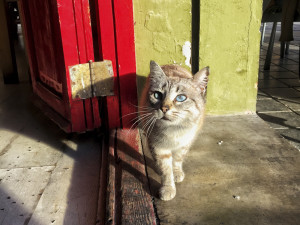A Cautionary Tale About a Cat in Heat
Experts explain why you should spay or neuter your kitten. Don’t learn the hard way like I did.

Share Article
I’ll admit it: I had kitten fever. The idea of one day having lots of orange kittens scampering around, carbon-copies of my perfect cat, seemed like a dream come true. “I just want more kitties exactly like her…” I flippantly commented to friends. They were not amused. One threatened to end our friendship if I didn’t get my cat spayed, citing the many reasons why it would be extremely irresponsible. I promised I would.
But then, between languishing through the pandemic, a cross-country move, and belatedly finding out that vets in my area were booked for months, I didn’t manage to get an appointment for some time. A few weeks before her slated spay surgery date, it started: frantic yowling that woke me up in the middle of the night. My cat looked panicked, skidding around the house and causing a horrific ruckus. My cat was in heat — the height of her fertility, when the biological desire to mate is overwhelming.
When my vet confirmed my suspicions, I burst into tears. As a pet parent, I felt like I’d failed her. She looked up at me, wide-eyed and uneasy, before resuming her agitated pacing from window to window in search of a “Tom” cat. Thankfully, her milkshake didn’t bring any boys to the yard. But the incessant noise continued, night and day, disrupting my sleep and my Zoom calls. “Apologies, my cat is in heat,” I’d explain, leaving my co-workers with confused expressions.
After six days, it stopped and the sweet cat I knew returned. And, thanks to the Cat Adoption Team (CAT)opens in new tab in Sherwood, Oregon, I was able to get her spayed before her next cycle. The largest cat-only shelter in the Pacific Northwest, CAT performs around 2,500-3,000 spay/neuter surgeries each year, including both pets through their low-cost clinic and homeless cats in their care prior to adoption.

According to Heather Svoboda Miller, CAT’s Communications and Development Manager, the best time to get your cat fixed is before the age of four months — when cats are old enough to breed. “Kittens spayed or neutered at a young age usually recover from surgery more quickly than adult cats do,” she says. And getting your cat fixed ASAP will spare your cat the anguish that mine experienced. “Being spayed or neutered can decrease the urge to yowl or try to escape from your home to find a mate. Neutering male cats can also prevent urine spraying and reduce fighting.”
Experts also point to the serious health risks that unaltered cats face, which should scare any pet parent. “When you have your cat spayed or neutered, you significantly decrease the chances of uterine or testicular infections and cancers developing, so your cat can live a longer and healthier life — and you can save money on future medical bills,” says Steve Gruber, Director of Communications at the non-profit organization Mayor’s Alliance for NYC’s Animalsopens in new tab. He also dismisses the “misconceptions that one’s cat will automatically become overweight or their personality will change after being spayed or neutered,” as well as “the belief that their cat should not be deprived of the right to reproduce. People shouldn’t project their feelings onto their cats — cats don’t care!”
Plus, cat overpopulation is a huge problem. Gruber says that although the exact number of stray and feral “community cats” is unknown, tens of thousands of cats are estimated to be living outdoors throughout New York City. “The cat overpopulation crisis is fueled by irresponsible cat owners who abandon their cats outdoors or allow their unaltered cats to roam and reproduce,” he says. “Despite the efforts of hundreds of individuals who perform Trap-Neuter-Return (TNR) on NYC’s community cats, resources to care for the cats and reduce their numbers over time are limited. “During COVID restrictions, the overpopulation problem worsened because of a tremendous slowdown in the availability of spay and neuter services.”
Over in Oregon, Miller at CAT also points to the challenge of overpopulation, putting into context how easily it can grow out of control. “Male cats can father countless litters annually and female cats can have up to three litters a year — that can translate to well over a hundred kittens in just a couple of years,” she says. “That many new animals put a strain on community and shelter resources, and contributes to the homeless cat population.”
If you truly love cats, you’ll help to make sure that yours can live the healthiest life possible, and support organizations like CAT and the Mayor’s Alliance for NYC Animals that are working to address a national crisis that can be prevented. As Miller says, “spaying and neutering is one of the most humane and scientifically proven ways to reduce stray cat populations, and that means fewer cats entering shelters or struggling on the streets.” Though the idea of bringing more kittens into the world might sound charming, the reality is not so cute when you think of the hundreds of thousands of adoptable cats in shelters who need loving homes. If you’re taking in an unaltered cat, set a date for their spay/neuter surgery. I learned my lesson and can only hope my experience will serve as a cautionary tale for others.

Mai Lynn Miller Nguyen
Mai Lynn Miller Nguyen is a freelance culture writer who launched a neighborhood publication called The Pet Times while in elementary school. She is a devoted (read: obsessed) pet parent to Pippi, a spirited little orange cat who was found in the wilds of Michigan in 2020, has since crossed the country three times, and loves to climb trees.
Related articles
![cat with cone after vet visit]()
How Often Should You Take Your Cat to the Vet?
Get thy cat to a vet, even if it’s a struggle to get them out the door.
![black scruffy dog wearing cone recovering from spay surgery]()
Everything You Need to Know About Spaying and Neutering Your Dog
A vet’s take on why it’s a smart choice. Snip, snip!
![A fluffy red-brown cat in a crate]()
How Flatbush Cats Is Saving Brooklyn’s Strays
Ad agency strategist Will Zweigart founded a nonprofit to tackle the neighborhood’s street cat epidemic.
![Sterling "Trapking" feeding a treat to an orange rescue cat]()
Sterling “TrapKing” Davis is Going Global
The rapper-turned-trapper quit his music career to start a cat rescue, has saved the lives of thousands of strays, and is promoting diversity in the animal welfare world. This spring, he’s taking things international.
![A cat with blue eyes standing before a door entrance.]()
How TNR Is Helping Outdoor Cats
Trap-Neuter-Return is the most humane way to keep stray cat populations in check. Here’s how it works.







